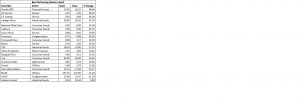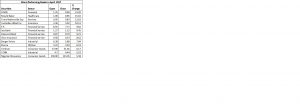
Market Roundup for April
After starting off with two losses and gains in the first four trading days of April, the market recovery mode that started in March was sustained, as the indices of the Nigerian Stock Exchange (NSE) finished the period under review on a positive note.
This was attributed to the earnings reporting season that supported the trend, as many shareholders smiled to and are still smiling to their banks, despite the mixed sentiments that followed 2016 financials due to the impact of weak macroeconomic business environment that weighed down many companies performance as revealed in the numbers they posted.
But as if to assure investors of good times ahead, the first quarter corporate earnings reports released in the final days of the month of April show improvement over the corresponding period in 2016 to signal recovery. Analysts agreed that if the companies are able to sustain the juicy Q1 numbers, prices can only close northward, just as investors would be assured of juicier reward in the form of dividend when the score-cards begin to flow into the market in the early days of 2018.
The weak market response to the positive numbers as at released dates so far, is an evident of low liquidity in the market and the economy at a time when the 2017 budget faced with so much uncertainty at this time of the year. It is one month to mid-year and the National Assembly is yet to approve and subsequently present a clean copy of the year’s Appropriation Bill for ascent by President Muhammadu Buhari, thereby slowing down the whole system and implementation of the administration’s much talked about Economic Recovery and Growth Plan (ERGP).
In addition to this, the government has continued to over crowd the financial market with high interest yielding instruments, thereby boxing the private sector to tight corner, especially with a high interest rate market where they are to source funds for productive activities.
Moreso, the few rays of hope, including the positive economic data, improving corporate earnings and the Central Bank of Nigeria (CBN) continued intervention in the forex market to meet the supply side with over $1bn already, are yet to boost confidence as liquidity in the system remains low and commodities prices remain prohibitive.
It must however be noted that market players have expressed high hope that these factors will impact the economy positively very soon, even as government and its team should continue to do the needful to ensure that the economy emerges stronger from this lingering recession. Government, they say, can do this and more to sustain growth by making new polices and reviewing the existing policies for adjustment. The continue rise in the nation’s external reserve to $30.80bn, despite the CBN’s sustained intervention in the forex market in its bid to stabilize the Naira against major global currencies in the period under review is a plus for the market and the economy despite the unstable price of oil that is a major source of government revenue. Improvement in the Naira’s value would become more pronounced when autonomous sources of the green back resume meaningful supply to help ensure improved liquidity in the system.
Meanwhile, the market in the last 18 trading sessions of the month has been oscillating to close higher after recording 9 trading days of down market and the same for up market for the period. The composite index NSEASI for the month of April gained 242.17 points to close at 25,758.51 from an opening figure of 25,516.34, representing 0.95% growth over the period.
The buying volume of total transactions for the month was 82%, while selling position was 18% to continue the previous month’s up market as volume index for the period was 0.59. Market capitalisation for the month gained N83.85 billion to close higher at N8.91trillion, from an opening value of N8.83 trillion, representing 0.91% appreciation in value, with the market having a bullish sentiment in expectations of Q1 scorecards that eventually beat investors and analyst’s estimates. The month’s traded volume was down by 32.30% to 3.92 billion shares from 5.79 billion in the previous month of March.
The benchmark index’s year-to-date negative position stood at 4.15%, just as market capitalisation for the same period adjusted up to N334.03bn, representing 4.09% loss YTD from the opening value.
Market breadth for the month was positive as the number of advancers outpaced the decliners in the ratio of 59:30 to continue the bull transition that reversed the first two months of down market of the year. During the period, more than 70% of listed companies with December year-end released their first quarter earnings reports to the market. The numbers were nonetheless mixed, but they surpassed market expectations especially the operators in the banking sector, which helped the service industry, which include the financial service providers and others to emerge on the best performing stocks chart for April.
The sectoral performance chart below shows that Industrial Goods sector propelled the market the most in the period under review. It gained 6.96%, which was more significant than that recorded by the benchmark NSE All Share Index; followed by the NSE Pension which rose by 5.93% to reflect the power of blue-chip dividend paying stocks. This was followed by the NSE Banking index, which moved 3.74% up, a situation that was attributed to the impressive numbers churned out by majority of the bank stocks, amidst their low Price-To-Earnings attraction in the sector. Other sectors that closed up during the month were: NSE Oil/Gas, NSE Main Board, NSE 30 Index, NSE Insurance and NSE Asem. On the downside, the NSE Premium led by 2.12%; followed by NSE Consumer Goods, 1.86%; and the NSE Lotus 2, 1.30%.

The month’s best performing stocks were Stanbic IBTC, which posted impressive 2016 full year and first quarter 2017 earnings reports despite low dividend payout during the period. It closed the month better by a significant 48.98% of its opening price; followed by Airservice, which appreciated by 40.32%; while C&I Leasing chalked all of 36.00%; and Lafarge Africa, 31.07%.
Low cap stocks among the top gainers for the month included: Learn Africa, 20.59%; Transcorp, 20.55%; and Honeywell flour, 19.05%; among others.

The decliners were led by FCMB, which lost 23.20%, linked substantially to its lean dividend payout and unimpressive Q1 2017 numbers that were released within the period; May & Baker lost 15%; Trans nationwide Express declined by 9.09%; Custodian Allied Insurance 10.12%; and ETI, 9.82% on the back of weak 2016 full-year and 2017 first quarter numbers.






